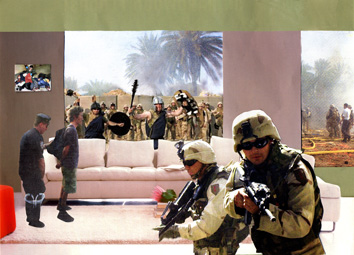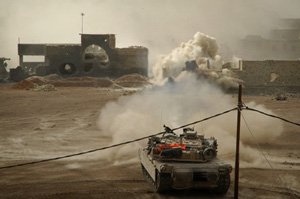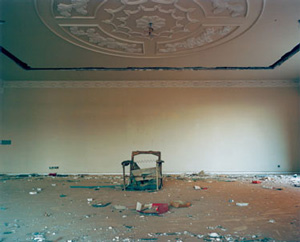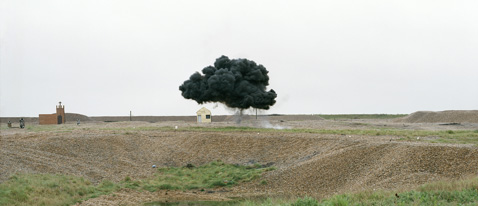War Fare

About the Exhibition
War Fare
Work by:
Ashley Gilbertson
Sean Hemmerle
Sarah Pickering
Martha Rosler
Sean Snyder
The five artists in this exhibition are interested in exploring the consumption of imagery as information about war. Some look directly at combat and its aftermath, trying to communicate from within the subject. Others seek out atypical views and the random, unnoted props of war—objects that range from the surreal to the prosaic and surround the reporting and waging of war in its various contexts. By focusing on these seemingly innocuous details, their work tells a larger story of how economic and corporate interests often intermingle with political ideology.
Five years after the attack on the United States by Al-Qaeda and well over three years into the “War on Terrorism” in Iraq and Afghanistan, the summer of 2006 has seen a shift in public opinion about the war—Americans are growing increasingly skeptical and impatient. The recently foiled plan to bomb airplanes leaving Great Britain once again uncovered terrorist cells in a major European capital, reminding us that terror can be bred anywhere. Subsequent polls show that most Americans think the fight in Iraq has no link to a larger anti-terror effort. And fifty-three percent of Americans believe that going to war was a mistake to begin with.
Public opinion polls, of course, continually shift, and often mirror the tenor of information we receive from media outlets—often the very ones who conduct the polls. And the media, pushed by its own complicated set of agendas, consistently titillates in pursuit of ratings and sales. As the artist Sean Snyder (American, b. 1972) observes in his video Casio, Seiko, Sheraton, Toyota, Mars (2004-2005), the information we receive about the war is a highly sensationalized stream of imagery that can be dissected as follows:
“News stories, scripted for consumption, merge the spaces of recent conflict. Plots, characters, and camera direction produce images for decoding. The sets can be cities, mountainous landscapes, hide-outs and tourist resorts. The plots include documents, dossiers, manuals, reports, un-released videos, un-circulated images, found mobile phone SIM cards, confiscated hard drives, and a largely unseen spectacle of incidental props.”
Snyder strings together images culled from government, amateur, and photojournalistic sources to loosely outline decades of foreign corporate involvement in Iraq and Afghanistan. The repeated appearance of products such as Mars candy bars, Toyota trucks, and Casio watches expose the capacity of media images to serve as accidental product placements.
Also interested in the proximity of advertisements to news stories, Martha Rosler (American, b. 1943) collages horrific photojournalistic images of war with cheery advertisements for consumer products such as cell phones and make-up. The first installment of the series Bringing the War Home was produced between 1967 and 1972 at the height of the war in Vietnam. The second installment of the series, about the war in Iraq, is still concerned with the absurdity of receiving grave information punctuated by fantasy images that arouse shallow material desires.
Sarah Pickering (British, b. 1972) explores the role of fantasy in the real-life preparation for war by allowing us a glimpse of rarely seen commodities—the scaled-down, mock explosives produced for use in military training exercises and action movie battle scenes. Pickering brings her camera to the sales demonstrations of these simulated pyrotechnics, detonated for executives from the military and movie industries. Like An-My Lê’s 29 Palms series, Pickering’s work exposes the theater involved in the preparation for war. As documents of a simulation, her pictures also allude to the unreliability of photographic information.
Finally, this exhibition contains the work of two photographers who bring their cameras into the actual war zones. A former U.S.Army sergeant, Sean Hemmerle (American, b. 1966) uses a large format camera to capture elegant views of the war-torn, abandoned landscapes of Iraq and Afghanistan that we don’t typically see in the media. He mixes these pictures with punchy color images of the arenas of war reporting and planning—television studios and CENTCOM war rooms—revealing, like Snyder, the slick packaging of war. Ashley Gilbertson (Australian, b. 1978), a photojournalist who won the 2004 Cornell Capa Award and whose work often appears on the front page of The New York Times, has literally risked his life to make pictures. Operating without irony, he makes photographs that manage to be at once gripping and classically beautiful. After considering the work of the other artists in this exhibition, however, it is clear that when viewing seductive images like Gilbertson’s in a newspaper, we must pay attention to the wider circumstances of their existence in the news media context.
As “decoders” of images, especially of war, it is our responsibility to take into account these many layers of context—political, ideological, and economic/commercial—detectable both in the content of an image and the surroundings of its dissemination, that profoundly shape its impact.
—Karen Irvine, Curator
Image Gallery




